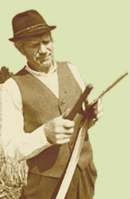The icy ploughs push boulders on shores
Kaarel Orviku has observed through decades how drift ice works as a giant plough, pushing erratic boulders from the sea bottom to our sea shores. The ice works as a plough only in certain conditions, however: the wind has to blow from one direction, piling the ice near or on the shore. The article is based mostly on numerous examples of certain cases, illustrated with plentiful characteristic photographs.
The sea gives, the sea takes, and the sea buries a man
Marju Kõivupuu and Valdeko Palginõmm take an insight into the way of life, traditions and beliefs of coastal people. Their views have foremost been influenced by fishing and dependence on sea. However, there is not much we know about the life of the coastal people, as the folk culture studies have traditionally been focused on farmers, men of land. The article presents several stories from archives, providing an idea of previous times, as well as values and beliefs related to life by the sea.
Life in a drop of water
Lennart Lennuk opens a door into the mysterious and diverse world of zooplankton in the Baltic Sea: al large part of this is till rather unknown for science. The species of zooplankton of the Baltic Sea are of very different size and shape: extending from the size of viruses to large Medusa, or jellyfish. The article introduces the most common groupss of phytoplankton living in the Baltic Sea the maxillopodans and cladocerans , but also several invasive species. The magnificent and exquisite illustrations of the article are drawn by the author.
The less known side of phytoplankton
Inga Lips gives an overview of phytoplankton in the Baltic Sea, including the peculiarities of feeding habits of the different species. While almost all phytoplankton species are obligate photoautotrophs, there are some that are mixotrophic and other, non-pigmented species that are actually heterotrophic. The author explains the feeding peculiarities of some mixotrophix species of the nanoflagellates.
Estonian Nature enquires
Agni Kaldma writes about the experience gained from the international shore line spill exercise Boilex.
The protein that regulates growth
Rainer Kerge elaborates on growth hormone, which stretches the young and cures wounds. A healthy and strong body has two types of growth hormone; one of which is normal and the other one abnormal. If the functioning growth hormone is not produced in sufficient amount, a person stays small, but lives a long life. And vice versa, those with growth hormone excess grow too much, but live a shorter life.
Interview: The Baltic Sea is an endless field of work for scientists
Toomas Kukk has interviewed Henn Ojaveer, a marine ecologist.
The drown heritage of the Baltic Sea
Maili Roio tries to find links associations between wrecks on the sea bottom and historical documents in archives. In order to get a better overview of the wrecks, the National Heritage Board has initiated an international project SHIPWHER: Shipwreck Heritage: Digitizing and Opening Access to Maritime History Sources. The project intends to find wrecks, but more importantly, to identify them based on the records of archives.
Kayaking provides a different look at the sea
Mart Reimann gives advice for beginners of kayaking: what should one know about preparations, equipment and dangers at sea. In addition, the author suggests a variety of kayaking routes on the northern and western coasts of Estonia. Estonian coast, especially the western coast is full of small islands perfect goals for day-long kayaking trips.
Routes to islets on islands: Kesse and Viire
Kadri Tüür is convinced that not only does the culture makes people move, but the traffic itself creates culture. The article focuses on two islets off the coast of the Muhu Island. In older times, the roads to and on the islands were much different from the hiking paths that prevail on the islet today. In future, when the needs and interests of people change again, the traffic network will be changed again.
BalticSeaNow.info develops marine awareness
Karin Ojamäe introduces an international project that intends to fit the sea into the world view of modern people. The project aims to enhance the environmental consciousness and activate citizens to discuss about the future of the Baltic Sea. BalticSeaNow.info -project produces a versatile and participatory web-forum, and organises a series of events and exhibitions. There are several outputs of the project, such as web cameras, blogs, photo contests and others.
The North-Estonian islands in print
Tiina Peil says that the cultural history of the Estonian coastal people is still little studied and gives a short overview of the related literature. In Soviet times the coast and island were forbidden territories and almost no research was possible. Lots of people were made to leave their homes and they usually left for abroad. Nowadays, their memoirs are being published, forming a large share of literature about coastal people.
|


![[IN ENGLISH]](images/gb.gif)






